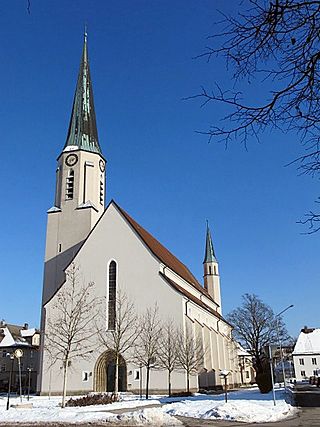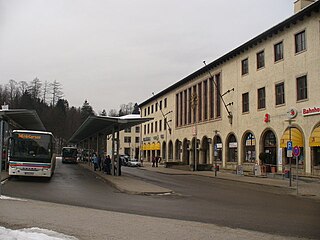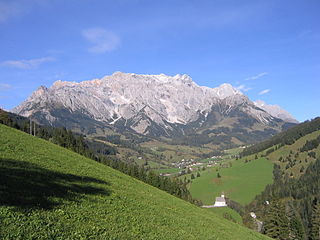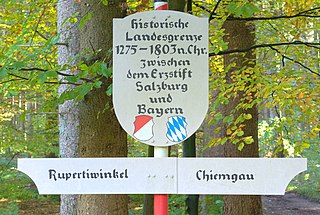
Berchtesgaden is a municipality in the district Berchtesgadener Land, Bavaria, in southeastern Germany, near the border with Austria, 30 km (19 mi) south of Salzburg and 180 km (110 mi) southeast of Munich. It lies in the Berchtesgaden Alps. South of the town, the Berchtesgaden National Park stretches along three parallel valleys.

The Salzach is a river in Austria and Germany. It is 227 kilometres (141 mi) in length and is a right tributary of the Inn, which eventually joins the Danube. Its drainage basin of 6,829 km2 (2,637 sq mi) comprises large parts of the Northern Limestone and Central Eastern Alps. 83% of its drainage basin lies in Austria, the remainder in Germany (Bavaria). Its largest tributaries are Lammer, Berchtesgadener Ache, Saalach, Sur and Götzinger Achen.
Traunstein is a Landkreis (district) in the southeastern part of Bavaria, Germany. Neighboring districts are Mühldorf, Altötting, the Austrian states Upper Austria and Salzburg, the district Berchtesgadener Land, the Austrian states of Salzburg and Tyrol, and the district Rosenheim.

Freilassing, until 1923 Salzburghofen is a town of some 16,000 inhabitants in the southeastern corner of Bavaria, Germany. It belongs to the "Regierungsbezirk" Oberbayern and the "Landkreis" (County) of Berchtesgadener Land. Located very close to the German-Austrian border, Freilassing can be seen as the biggest satellite of Salzburg, the centre of which is eight kilometres away, on the other side of the border.

The Saalach is a 105-kilometre-long (65 mi) river in Austria and Germany, and a left tributary of the Salzach.

Piding is an approved climatic spa in Bavaria near to the border of Austria close to Bad Reichenhall and Freilassing.

Berchtesgaden Provostry or the Prince-Provostry of Berchtesgaden was an immediate principality of the Holy Roman Empire, held by a canonry led by a Prince-Provost.

Berchtesgaden Hauptbahnhof is a railway station in the Bavarian market town of Berchtesgaden, the smallest town in Germany with a Hauptbahnhof. It has five platform tracks and is classified by Deutsche Bahn as a category 5 station. It is the terminus of the Freilassing–Berchtesgaden railway. Previously the Berchtesgaden–Hangender Stein railway, also called the Grüne Elektrische started from the station. Within walking distance of the station (Triftplatz) was the former station of Königssee Railway, which served the lake of Königssee. The station is served by about 20 trains daily operated by Deutsche Bahn and the Berchtesgadener Land Bahn.

Schönau am Königssee is a municipality in the district of Berchtesgadener Land in the German state of Bavaria. It is located at the northern end of the Königssee lake.

Wals-Siezenheim is a municipality in the district of Salzburg-Umgebung (Flachgau) in the Austrian state of Salzburg.

The Electorate of Salzburg, occasionally known as the Grand Duchy of Salzburg, was an electoral principality of the Holy Roman Empire from 1803–05, the short-lived successor state of the Prince-Archbishopric of Salzburg.

The Berchtesgaden Alps are a mountain range of the Northern Limestone Alps, named after the market town of Berchtesgaden located in the centre. The central part belongs to the Berchtesgadener Land district of southeastern Bavaria, Germany, while the adjacent area in the north, east and south is part of the Austrian state of Salzburg.
The Saalach Valley is the name of the middle and upper reaches of the Saalach, a mountain river in the Austrian state of Salzburg and the southern part of the German state of Bavaria.

The Rupertiwinkel is a small historic region on the southeastern border of Bavaria, Germany. Part of the Archbishopric of Salzburg until the early 19th century, it is named after the first Salzburg bishop Saint Rupert (c.660–710), apostle to the Duchy of Bavaria.
The Rosenheim–Salzburg railway is a continuous double track and electrified main line railway almost entirely within the German state of Bavaria. It is an international transport corridor, linking Rosenheim to Salzburg in Austria.

Freilassing station is located in the Upper Bavarian district of Berchtesgaden. It is the last German station on the railway line from Munich to Salzburg, a border station to Austria and the only station in the town of Freilassing.

The Salzburg S-Bahn is a large transport project in and around Salzburg in the Euroregion of Salzburg–Berchtesgadener Land–Traunstein, which crosses the border between Austria and Germany. Its S-Bahn network has been partially in operation since 2004 and its first stage was opened in 2014.

The Freilassing–Berchtesgaden railway is an electrified line listed in the Deutsche Bahn timetable as route 954. The 33.671 km long route branches in Freilassing as a single-track line from the double-track Rosenheim–Salzburg railway. It is classified as a line as far as Bad Reichenhall and from there as branch line. The section between Bad Reichenhall-Kirchberg and Hallthurm is considered a steep section with specific operational requirements under Deutsche Bahn's regulations.

The Austria–Germany border has a length of 815.9 km (507.0 mi) or 815.0 km (506.4 mi) in the south of Germany and the north of Austria in central Europe. It is the longest border of both Austria and Germany with another country.

Traunstein is an electoral constituency represented in the Bundestag. It elects one member via first-past-the-post voting. Under the current constituency numbering system, it is designated as constituency 225. It is located in southern Bavaria, comprising the districts of Berchtesgadener Land and Traunstein.























